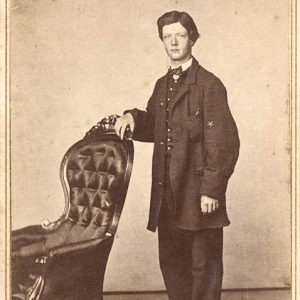calsfoundation@cals.org
Sixtieth U.S. Colored Infantry Regiment
aka: First Regiment Iowa African Infantry
The Sixtieth U.S. Colored Infantry Regiment was formed in 1863 from companies raised in Iowa and Missouri; it saw most of its service in Arkansas.
The recruiting of African American men for military units to serve in the Union army was approved with the creation of the U.S. War Department’s Bureau of Colored Troops on May 22, 1863. At least seven regiments of Black troops and two artillery batteries manned by Black soldiers were raised in Arkansas; the unit that became the Sixtieth U.S. Colored Infantry Regiment was raised out of state but served most of its time in Arkansas.
The U.S. War Department issued special orders on July 27, 1863, authorizing Colonel William A. Pile to organize a Black regiment in Iowa. Even though there were only around 1,500 African Americans in the state at the time, six companies were mustered into service on October 11, 1863, at Keokuk, Iowa. They would be joined by four companies formed in Missouri, and the First Iowa Regiment of African Descent would contain 911 men when the last company mustered in on December 4, 1863.
Captain John G. Hudson of Company B, Thirty-Third Missouri Infantry Regiment—who while in command of Battery D in the July 4, 1863, Battle of Helena was asked by enemy soldiers by what authority he called for their surrender and famously replied: “By the authority of my twelve-pound howitzer”—was appointed colonel of the First Iowa (AD) on September 21, 1863. He would lead the regiment until it mustered out in 1865.
The Iowa companies left for St. Louis, Missouri, on November 12, 1863, and the complete regiment departed for Helena (Phillips County) on December 20. As 1864 dawned, the First Iowa men spent much of their time repairing the batteries and rifle pits that protected the town but also participated in expeditions on the Mississippi, White, and St. Francis rivers “besides expeditions through the country on foot, taking a good many prisoners and meeting with no loss.”
The regiment’s designation was changed to the Sixtieth U.S. Colored Infantry Regiment on March 11, 1864. The men of the Sixtieth also served as heavy artillerymen, manning all the batteries and fort at Helena, according to a November 28, 1864, letter from Hudson, then a colonel.
Men of the Sixtieth saw their first combat on July 26, 1864, at Wallace’s Ferry, where Confederates under Colonel Archibald Dobbins attacked them during a U.S. expedition to Big Creek, killing and wounding several men. Elements of the regiment also served in the August 11–13, 1864, expedition to Kent’s Landing, an August 29 to September 3 expedition up the White River, several scouting runs to Alligator Bayou in September and October, and an expedition to Harbert’s Plantation in Mississippi from January 11 to January 16, 1865.
The Sixtieth was transferred to Little Rock (Pulaski County) on March 21, 1865, arriving there on April 10 and serving there until August 20. During that period, an officer of Company D noted that “the men have made a great improvement in the performance of all their duties as soldiers and, at the same time, made progress in learning to read and write.”
After leaving Little Rock in August 1865, elements of the regiment served at DeValls Bluff (Prairie County); at Jacksonport (Jackson County); and in the Sub-District of the White River, at Powhatan (Lawrence County) and Batesville (Independence County), among other locations. The Sixtieth mustered out at DeValls Bluff on October 15, 1865, and was discharged on November 2. The regiment had a total enrollment of 1,153 officers and enlisted men, of whom eleven were killed in action, three were wounded (one mortally), and 332 died of disease.
A postwar history of the regiment stated that “when the call to arms was extended to them, they responded as freely—in proportion to their numbers—as had the men of other races….The opportunity to enroll themselves among the Nation’s defenders was long delayed, but, when it came, they were found ready and eager to take part in the struggle which ended in the emancipation of four millions [sic] of their race from the degradation of human slavery.”
Colonel Hudson received a brevet promotion to brigadier general on October 9, 1867, for “distinguished gallantry at the battle of Helena, Ark., July 4, 1863.”
For additional information:
Brodnax, David Sr. “‘Will They Fight? Ask The Enemy’: Iowa’s African American Regiment in the Civil War.” Annals of Iowa 66 (Summer/Fall 2007): 266–292.
Dyer, Frederick. A Compendium of the War of the Rebellion. Des Moines, IA: Dyer Publishing Co., 1908.
Hewett, Janet B., et al., eds. Supplement to the Official Records of the Union and Confederate Armies, Vol. 78. Wilmington, NC: Broadfoot Publishing Co., 1998.
Roster and Record of Iowa Soldiers in the War of the Rebellion. Des Moines, IA: Emory H. English, 1911.
Mark K. Christ
Central Arkansas Library System
 Civil War through Reconstruction, 1861 through 1874
Civil War through Reconstruction, 1861 through 1874 Military
Military John G. Hudson
John G. Hudson  James Morgan
James Morgan  James Morgan
James Morgan  John L. Murphy
John L. Murphy 



Comments
No comments on this entry yet.